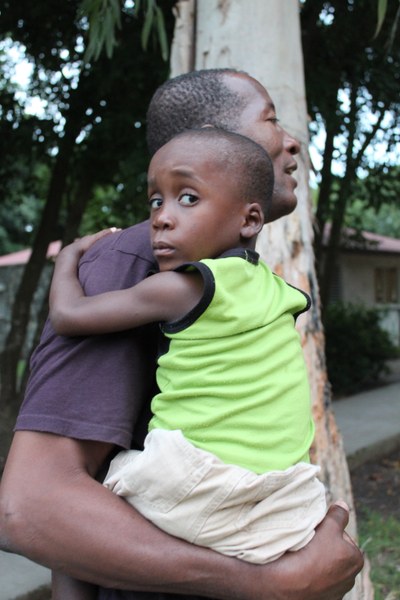Haiti child stories: Bringing families back together

Find out what happened to some of the 33 children who were smuggled over the border by ten US citizens, picked up by the authorities, and then cared for in SOS Children's Village Santo in Port-au-Prince for several weeks
SOS worker Georg Willeit, from Austria, was on site in Haiti just a week after the earthquake: his purpose - to co-ordinate international communications for SOS Children's Villages for a month and help with every possible logistical challenge during this critical first phase.
Nine months later he returned to Port-au-Prince:
"As soon as the emergency relief work began, SOS Children's Villages in Haiti was determined to take in unaccompanied children and reunite them with their families wherever possible. Happily, this has been successful in over 150 cases to date. There were various reasons for taking them into SOS Children's Villages, apart from the scale and intensity of the earthquake on 12 January 2010, of course.
Besides the children who had demonstrably lost their family and needed a new home on a long-term basis, the past months saw a series of short-term care needs that applied to children who were temporarily not able to live with their family of origin. Then there were unaccompanied children who were left to their own devices in one of the many camps. And we also had the 33 children who were smuggled over the border by ten US citizens, picked up by the authorities, and then cared for in SOS Children's Village Santo in Port-au-Prince for several weeks. On my last visit I went to see some of these families in Haiti, and never fail to be deeply moved even now by their stories and experiences.
Little Paul came to SOS Children's Village Santo in mid-May. The adults in one of the emergency relief camps gave him the name Paul, and this was what the International Red Cross workers also called him when they brought the three-year old to the SOS Children's Village. Until then, Paul had been living in one of the big emergency relief camps, where his carers changed constantly and provided varying levels of care. Samuel, his real name, somehow just went along with it all. Thankfully the Red Cross staff realised that 'Paul' was an unaccompanied child; no one was taking care of him properly, though he was very welcome when it came to getting bigger food rations. He spent four months in this camp, and no-one knew if his parents were still alive, or if he had brothers and sisters. He was taken into an SOS family in the SOS Children's Village in Santo. The Red Cross workers, however, did not stop looking for his family, and pinned up photos of the little boy in Port-au-Prince. It was mid-July when his parents saw one of these photos, and came to Santo to collect their son Samuel, after all their papers had been checked by the Red Cross. At first Samuel did not recognise his parents, which was hardly surprising, as he had not seen them for six months. Samuel lost his twin brother in the earthquake, and his sister was injured. Today he is back living with his family. He is well, back in his own house, and his parents can still scarcely believe their luck months later.
The second visit took me to the family of sisters Leila and Soraja, who are four and five years old. We travelled to Calabasse, where most of the 33 children taken by the US citizens came from. A journey of over two hours from Port-au-Prince, it lies in the heart of the green, fertile countryside: fruit and vegetable fields, small-scale farms, and houses hardly touched by the disaster. It all seems far removed from the tragedy that stuck the capital. And yet there was an indirect link with the earthquake and the exceptional circumstances in the weeks that followed. Leila and Soraja were two of the 33 children. Now they are all back with their parents again. For all of these children in fact had, and still have, their parents. Leila and Soraja live in a small house with their family. Their father is a teacher and also runs a small cybercafé, while their mother is unemployed. Their grandparents live in the house next door, the community is a manageable size, and everyone helps each other. Yet this environment - actually intact in Haitian terms, especially after 12 January - was to be destroyed and families torn apart.
The people here have problems, as work, schools and prospects for the future are not good. But the reaction to this cannot be the promise of a good life far away from the parental home. A legitimate response from external aid workers must involve changing the conditions in the region, strengthening local resources and providing income support, etc. Parents were told that the children could have a better life somewhere else, that children here in Haiti would never receive a good education. Loving parents who want the best for their children and are in a difficult situation can be receptive to these arguments, especially with the prospect of supposedly being able to visit the children at any time.
How tempting must it be in adverse circumstances, to think that your own children might have the chance of a better life than yours? Leila and Soraja seem well-balanced and happy. The two of them still remember the weeks they spent in SOS Children's Village Santo. "There were lots of friends, fun and games there". With a smile, they both also think back to the SOS mother whose family they joined temporarily, when they say: 'Tell Josephine from House 18 that we send our love.' "
Find out how you can support our work in Haiti by starting an emergency relief sponsorship or start sponsoring now

 Return to Schools Wikipedia Home page…
Return to Schools Wikipedia Home page…
